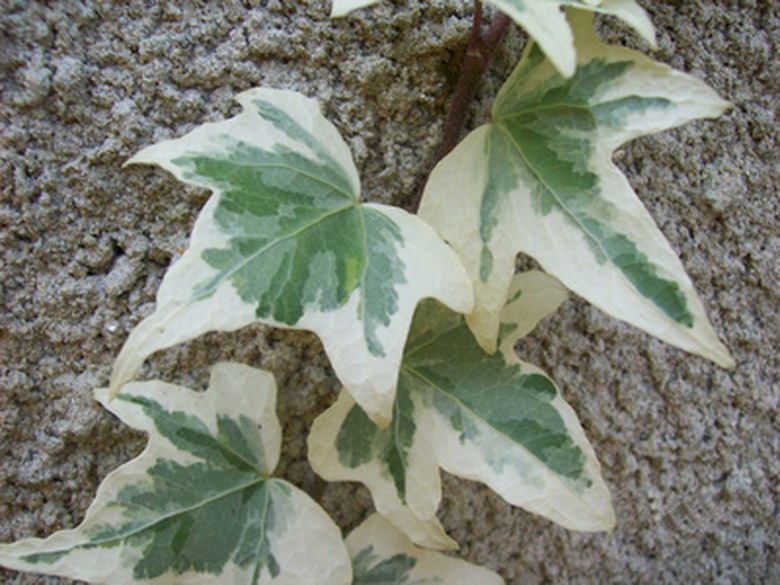Baltic Vs. English Ivy
Many different plants have the word "ivy" in their common names, but most often ivy refers to plants belonging to the botanical genus Hedera. Among the most widely used in outdoor gardens, as indoor houseplants or grown as topiaries, is the species called English ivy (Hedera helix). Baltic ivy (Hedera helix var. baltica) is a natural variant of English ivy although nurseries and literature may list this plant as a cultivar.
Origins
English ivy is native to the vast majority of the European continent. According to the Tropicos plant database listings of the Missouri Botanical Garden, there are numerous natural varieties and forms of English ivy across Europe as well as into western Asia and extreme northern Africa along the Mediterranean. Baltic ivy is one such natural variety, native to the woodlands around Latvia. This plant was first introduced into the United States in 1907 and planted at the Arnold Arboretum in Massachusetts.
- Many different plants have the word "ivy" in their common names, but most often ivy refers to plants belonging to the botanical genus Hedera.
- Baltic ivy is one such natural variety, native to the woodlands around Latvia.
Types
While there is only one Baltic ivy, horticulturists have further bred, genetically manipulated and selected various forms of English ivy. Today there are hundreds of man-made varieties (cultivars) that display variously sized, colored and shaped leaves for a wide array of ornamental garden purposes.
Features
As commented in a 1932 publication from the Arnold Arboretum, there is little physical visual difference among the wild form of English ivy with Baltic Ivy. Perhaps the key distinguishing features, according to that document and the American Horticultural Society's "A-Z Encyclopedia of Garden Plants," is that Baltic ivy's leaves are slightly more heart-shaped and have noticeable white veins. Besides that, these ivies are both vigorous growing vines that cling onto other structures for support with five-lobed leaves that are glossy and dark green. Plants are more petite and "vine-like" in their juvenile form, and when large and aged in their adult form, both ivies create bushier, shrub-like branches and produce flowers in the fall. The flowers are rounded clusters of many tiny five-lobed yellow-green flowers that later become round blackish berries.
- While there is only one Baltic ivy, horticulturists have further bred, genetically manipulated and selected various forms of English ivy.
- Perhaps the key distinguishing features, according to that document and the American Horticultural Society's "A-Z Encyclopedia of Garden Plants," is that Baltic ivy's leaves are slightly more heart-shaped and have noticeable white veins.
Growing Considerations
Both English and Baltic ivies grow best in fertile, moist, well-drained soils that have lots of organic matter. They do tolerate a wide range of soil types. In hot summer climates, these ivies are best grown in partial shade to prevent leaf scald or browning from the intense sunlight or dry, warm soils. In cooler summer regions, full sun exposures work well as long as soil doesn't become bone dry. When either of these plants is grown indoors as a houseplant, it requires very bright indirect light and should be watered and fertilized monthly. In the winter months, the soil should be allowed to become slightly dry to barely moist, and reduce or omit any fertilization.
Concerns
Generally speaking, English and Baltic ivy have the potential to become invasive in regions with fertile soil and mild climates, such as in the American Pacific Northwest and East. It is hardy to winter temperatures down to -10 to -20 degrees F for brief periods, although the modern, ornately foliaged cultivars are less tolerant to cold, often surviving temperatures no lower than 10 to 20 degrees according to "A-Z Encyclopedia of Garden Plants." Thus, English ivy is appropriate to grow outdoors in U.S. Department of Agriculture hardiness zones 5 through 10. Baltic ivy is more tolerant of winter cold than standard English ivy, as noted by the Arnold Arboretum. Baltic ivy can be grown outdoors successfully in USDA zones 4 through 10. Regardless, to retain the evergreen leaves on both of these ivies, they should not be exposed to cold, drying winter winds and warm, drying winter sun in cold climate areas.
- Both English and Baltic ivies grow best in fertile, moist, well-drained soils that have lots of organic matter.
- In hot summer climates, these ivies are best grown in partial shade to prevent leaf scald or browning from the intense sunlight or dry, warm soils.
References
- Harvard University's Arnold Arboretum: Baltic Ivy
- "A-Z Encyclopedia of Garden Plants"; Christopher Brickell and H. Marc Cathey, eds.; 2004
